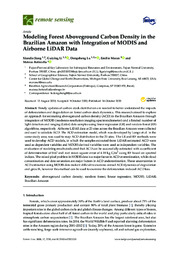Modeling forest aboveground carbon density in the Brazilian Amazon with integration of MODIS and Airborne LiDAR data.
Modeling forest aboveground carbon density in the Brazilian Amazon with integration of MODIS and Airborne LiDAR data.
Summary: Abstract: Timely updates of carbon stock distribution are needed to better understand the impacts of deforestation and degradation on forest carbon stock dynamics. This research aimed to explore an approach for estimating aboveground carbon density (ACD) in the Brazilian Amazon through integration of MODIS (moderate resolution imaging spectroradiometer) and a limited number of light detection and ranging (Lidar) data samples using linear regression (LR) and random forest (RF) algorithms, respectively. Airborne LiDAR data at 23 sites across the Brazilian Amazon were collected and used to calculate ACD. The ACD estimation model, which was developed by Longo et al. in the same study area, was used to map ACD distribution in the 23 sites. The LR and RF methods were used to develop ACD models, in which the samples extracted from LiDAR-estimated ACD were used as dependent variables and MODIS-derived variables were used as independent variables. The evaluation of modeling results indicated that ACD can be successfully estimated with a coecient of determination of 0.67 and root mean square error of 4.18 kg C/m2 using RF based on spectral indices. The mixed pixel problem in MODIS data is a major factor in ACD overestimation, while cloud contamination and data saturation are major factors in ACD underestimation. These uncertainties in ACD estimation using MODIS data make it dicult to examine annual ACD dynamics of degradation and growth, however this method can be used to examine the deforestation-induced ACD loss.
Publication year: 2020
Types of publication: Journal article
Observation
Some of Embrapa's publications are published as ePub files. To read them, use or download one of the following free software options to your computer or mobile device. Android: Google Play Books; IOS: iBooks; Windows and Linux: Calibre.
Access other publications
Access the Agricultural Research Database (BDPA) to consult Embrapa's full library collection and records.
Visit Embrapa Bookstore to purchase books and other publications sold by Embrapa.

